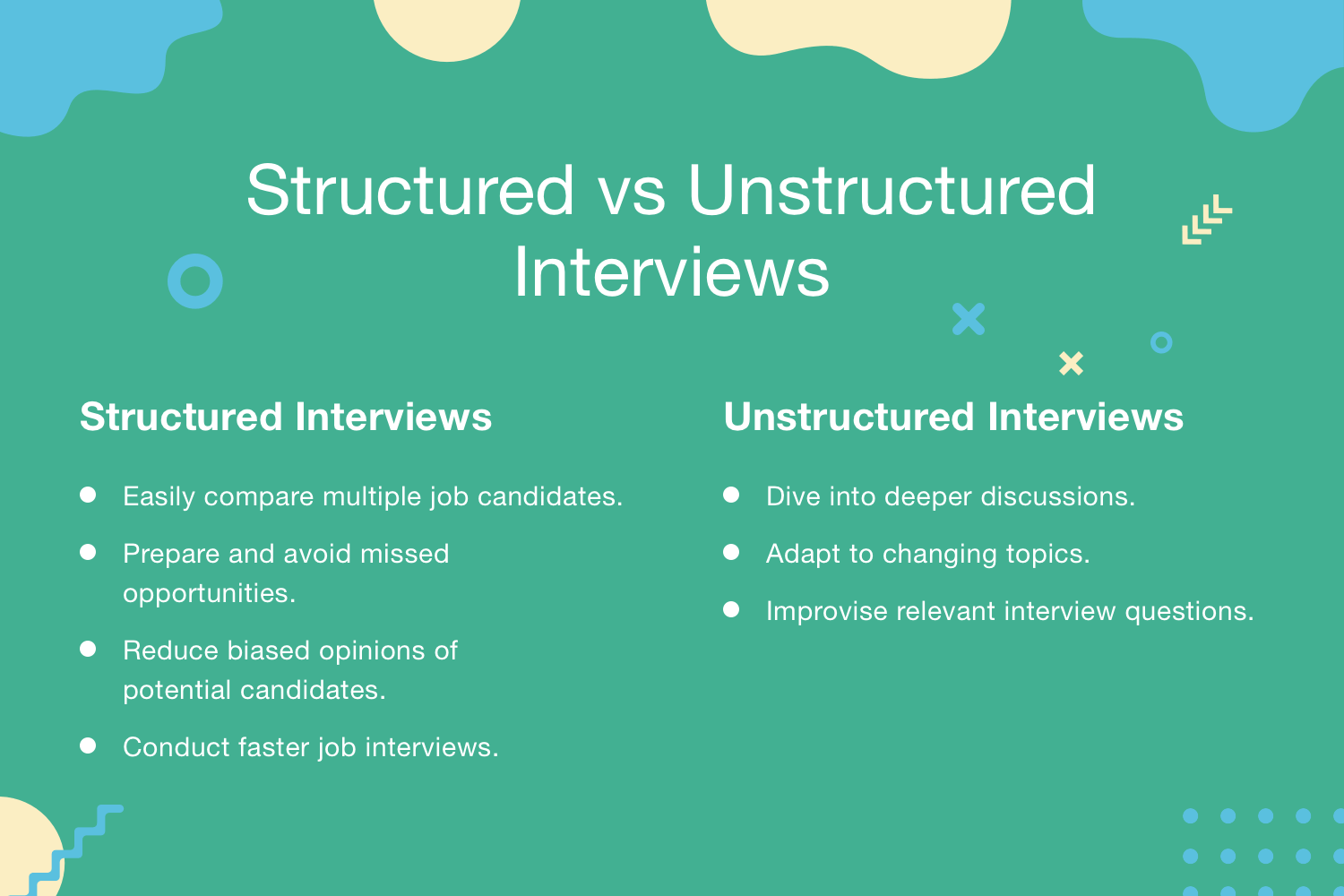There are two basic styles, or models, of interviews employers usually use when hiring new employees: structured and unstructured interviews. Just like job candidates, each one has its own strengths and weaknesses. But do the advantages of a structured interview outweigh the advantages of an unstructured interview?
As a hiring manager or business owner, you want to find the model that gets the best results. You want the one that helps you find the right candidates as quickly as you can, so you can get the right person on the job to help your company grow.
Fortunately, there’s a way to combine the best of both structured and unstructured interview models – but before we explore that, let’s take a look at the definitions, differences, as well as pros and cons, of both types.
- Structured interviews involve a set list of questions and yield benefits such as consistency and fairness in hiring processes.
- Unstructured interviews, on the other hand, often start with small talk and can provide different positive outcomes compared to structured interviews.
- Studies suggest that structured interviews are generally superior in hiring, offering better results.
- However, structured interviews come with their own set of drawbacks that need to be considered when choosing between structured and unstructured formats.
What is a structured interview?
A structured interview is a standardized interview format where the hiring manager asks all job candidates the same set of predetermined questions in the same order. This approach focuses on gathering comparable data on each candidate's past experience, strengths and weaknesses, job requirements, and the abilities and assets they can bring to the company.
In a structured interview, the employer often begins with some small talk and a brief overview of the position and then goes through the list of questions, writing down the responses for each one. For example, structured interviews could include questions such as “Tell me about a situation where you faced a challenging client and how you resolved the issue.” or “How do you prioritize your tasks when presented with a tight deadline?”
Each candidate is asked the same questions in the same order, while the interviewer takes notes and tries to get a sense of whether the person has the skills and traits necessary for the job, and whether he or she would be a good fit for the position and company.
Pros and cons of a structured interview
Conducting structured interviews within your company can yield many benefits.
The advantages of structured interviews include:
- Easily compare multiple job candidates. Since you ask each person the same questions, you can compare all the candidates’ answers across the board more easily.
- Prepare and avoid missing information. You’re less likely to forget important questions when you have a prepared list.
- Reduce biased opinions of potential candidates. In general, structured interviews are more consistent, fair and effective. Focusing on questions and answers rather than whether you “like” the candidate or not creates a more controlled environment and helps to remove the influence of personal bias.
- Conduct faster job interviews. Once prepared, structured interviews tend to be faster to complete than unstructured interviews.
The disadvantages of structured interviews are:
- Spend more of your time planning. Structured interviews take more time to plan and prepare, compared to unstructured interviews.
- Miss opportunities to go more in-depth. If you need more information, it’s more difficult to stray from the format and ask more in-depth questions on any areas of interest.
- Present your organization in a more professional or cold manner. These interviews can feel more impersonal – more like an interrogation than a conversation. And because they’re more formal, you may not be able to gauge personality traits and characteristics that you might observe in a more informal interview.
Move beyond resumes, identify true potential
Make smarter hiring decisions using objective data on candidates' strengths, work styles, and personality traits.
Examples of when to use the structured interview method
Here are some examples of situations where structured interviews might be used:
- Large-scale hiring: When a company needs to hire a large number of candidates for similar positions, using a structured interview ensures a consistent evaluation process for all applicants. This approach helps compare candidates objectively and fairly across the board.
- Entry-level positions with well-defined requirements: For entry-level positions with clear requirements and skill sets, a structured interview can efficiently assess if candidates possess the necessary qualifications.
- Assessing specific skills or knowledge: When there's a need to evaluate candidates on their knowledge or ability to perform specific tasks, a structured interview format can ensure these aspects are covered consistently across all interviews.
- Evaluating behavioral tendencies: Structured interviews can incorporate behavioral interviewing questions, which ask candidates about "STAR" situations (Situation, Task, Action, Result) to assess their past behavior and predict their future performance.
- Legal compliance: In certain industries or situations, structured interviews might be necessary to comply with legal regulations or company policies that require a standardized evaluation process.
It's important to note that while structured interviews offer many benefits, they might not be suitable for all situations. For roles requiring in-depth discussions of experience and skills, or assessing candidates' potential and fit with the company culture, a less structured approach might be more appropriate.
What is an unstructured interview?
Unstructured interview is a conversational, unrehearsed interview format without a specific list of questions. The interviewer may pick and choose things to talk about based on the candidate’s resume or application, while trying to assess how well the person might fit in with the company culture. These interviews are more like a free-flowing discussion mixed in with interview questions. For example, unstructured interviews may include questions such as “Tell me about yourself” or “Why are you interested in this position?”

Pros and cons of an unstructured interview
Unstructured interviews can yield much different positive results than a structured interview, so it’s important to weigh the pros and cons between the two.
The advantages of unstructured interviews include:
- Dive into deeper discussions. An unstructured interview model allows you to go more in-depth on a particular topic or focus more time learning about a particular candidate’s strengths or traits.
- Adapt to changing topics. Unstructured interviews are more flexible, allowing questions to be adapted and changed depending on the candidate’s answers.
- Improvise relevant interview questions. If the interviewer is good at coming up with questions on-the-spot and making the candidate feel comfortable, it can create a more relaxed atmosphere.
The disadvantages of unstructured interviews are:
- Getting distracted during the interview. Without having questions prepared in advance, you may forget something or miss learning about a trait or skill that’s critical for the job.
- Misjudging the interviewee. Because your questions may vary greatly from one candidate to another, it’s much harder to “compare apples to apples” when reviewing answers. It may also become easier to be affected by biases or snap judgments.
- Unpredictability of the candidate’s job performance. Depending on the person conducting the interview, unstructured interviews can be less reliable at predicting job performance if the right questions aren't asked. This can diminish the likelihood of the right candidates being selected.
Examples of when to use the unstructured interview format
Unstructured interviews offer a more conversational approach compared to their structured counterparts. Here are some examples of when an unstructured interview might be used:
- Senior-level positions: For senior-level or leadership roles, where experience and fit with the company culture are crucial, an unstructured interview allows for a more in-depth exploration of the candidate's background, leadership qualities, and strategic thinking.
- Creative or specialized roles: When the position requires specific skill sets or knowledge that are difficult to quantify through standard questions, an unstructured interview allows for a flexible exploration of the candidate's expertise and unique abilities.
- Research and development settings: In research or development environments, where innovation and creativity are crucial, an unstructured interview allows for more open-ended inquiries and discussions about the candidate's ideas and problem-solving approaches.
- Getting to know the candidate: When the goal is to gain a deeper understanding of the candidate beyond their resume and experience, an unstructured interview format can provide a space for a more natural conversation and exploration of personal qualities and career aspirations.
- Pilot interviews or reference checks: During pilot interviews or conversations with references, where the purpose is to gather additional information or clarify details, an unstructured approach allows for a more flexible exchange of information.
It's important to remember that while unstructured interviews offer flexibility, they can also be prone to bias due to the lack of a standardized format. Careful preparation and active listening skills are crucial to ensure objective evaluation and gather valuable insights from the conversation.
Structured vs. unstructured interviews: Which should you choose?
Numerous studies have found that structured interviews are superior in hiring, providing better results – however, as noted above, the advantages of structured interviews also come with drawbacks.
But the good news is, a pre-employment testing system like Hire Success allows you to reap all the benefits of both structured and unstructured interview models to create a kind of “superstructured” interview. Here’s how:
- Get ahead with filtered test results. By administering preliminary skills, integrity, and personality testing to all pre-qualified candidates, you start off with many answers to important structured interview questions before you ever hold interviews, just by reviewing test results done by the system. You’ll save a lot of valuable time as the people who don’t meet your baseline needs won’t be coming in to interview in the first place.
- Receive important candidate highlights before the interview. Having testing results speeds up the process of planning a structured interview, versus an unstructured interview, because Hire Success highlights important points for you in our reports. You also won’t forget to ask important questions, because our Interviewer’s Guide will help plot out queries.
- Discover candidate personality traits to find the right fit for the job. With results from a personality profile test, you’ll already have insight about personality traits that you’ve identified as being critical for the job. You can concentrate your time on areas of concern for each candidate, making each interview more personal.
- Create a controlled interview environment. Test results help you remain unbiased, because they focus on data. In fact, your data-based test results are more likely to help you identify candidates who might otherwise have been missed.
It’s best to keep in mind your business’s needs and objectives when deciding which type of style is best for your interviewing process. Choosing Hire Success’s interviewing system can help you bridge the gap between the advantages of structured vs. unstructured interviews.
Want to know more about our hiring system? Get a personalized walk-through of Hire Success's interviewing solutions.
Latest Stories
Here’s what we've been up to recently.

Why Hiring Takes So Long and How to Speed It Up
Talent shortages and increased competition made hiring difficult in a pandemic. Top candidates were often swept off the market quickly, meaning businesses who failed to act fast were left to hire from a smaller, less-qualified applicant pool.
Kelly Cantwell

10 Common Interview Problems & How to Address Them
Have you ever discovered that a person you hired to do a job – someone you felt you really “knew” after an extensive resume review and interview process – turned out to be totally different than what you expected? If you find yourself with consistent bad hires, your interview process is likely to blame. It may be time to evaluate your interview method, make sure you're asking the right questions, and decide what kind of answers produce the most successful hires. Let's take a look at common challenges with your job interviews (in person and remote) and discuss how to overcome them.
Kelly Cantwell

Hiring Process Checklist: A Step-By-Step Guide
Talent acquisition is more competitive than ever today. Employers face the tightest job market in history: low unemployment rates, high job mobility and a wide skills gap. It's more difficult to fill critical jobs. Companies large and small need to develop an efficient hiring process to attract, identify, and hire people with the right skill sets and attributes to fit your team.
Kelly Cantwell
Get our stories delivered
From us to your inbox weekly.